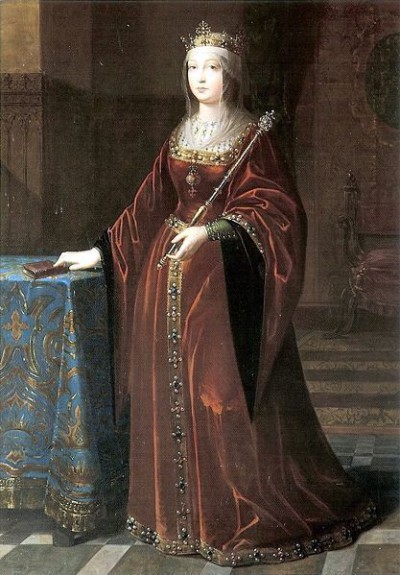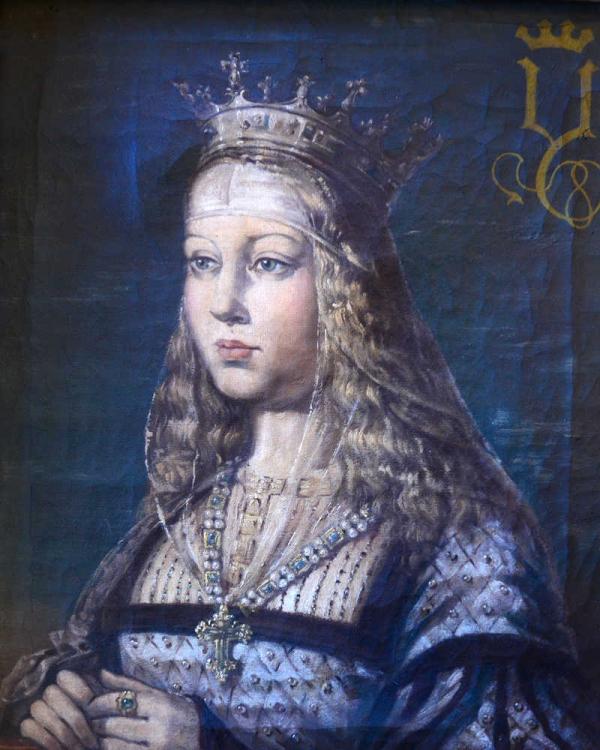Isabella I of Castile (Isabella I of Castile )

Isabella was born in Madrigal de las Altas Torres, Ávila, to John II of Castile and Isabella of Portugal on 22 April 1451. At the time of her birth, she was second in line to throne after her older half-brother Henry. Henry was 26 at that time and married but childless. Her younger brother Alfonso was born two years later on 17 November 1453, lowering her position to third in line. When her father died in 1454, her half-brother ascended to the throne as Henry IV. Isabella and Alfonso were left in Henry’s care. She, her mother and her brother Alfonso then moved to Arévalo. These were times of turmoil for Isabella. Living conditions in their castle in Arévalo were poor, and they suffered from a shortage of money. Although her father arranged in his will for his children to be financially well taken care of, Henry did not comply with their father’s wishes, either from a desire to keep his half-siblings restricted or from ineptitude. Even though living conditions were lackluster, under the careful eye of her mother, Isabella was instructed in lessons of practical piety and in a deep reverence for religion. When the King’s wife, Joan of Portugal, was about to give birth to their daughter Joanna, Isabella and Alfonso were summoned to court (Segovia) to come under the direct supervision of the King and to finish their education. Alfonso was placed in the care of a tutor while Isabella became part of the Queen’s household.
Some of Isabella’s living conditions improved in Segovia. She always had food and clothing and lived in a castle that was adorned with gold and silver. Isabella’s basic education consisted of reading, spelling, writing, grammar, mathematics, art, chess, dancing, embroidery, music, and religious instruction. She and her ladies-in-waiting entertained themselves with art, embroidery, and music. She lived a relaxed lifestyle, but she rarely left Segovia as Henry forbade this. Her half-brother was keeping her from the political turmoils going on in the kingdom, though Isabella had full knowledge of what was going on and of her role in the feuds. The noblemen, anxious for power, confronted King Henry, demanding that his younger half brother Infante Alfonso be named his successor. They even went so far as to ask Alfonso to seize the throne. The nobles, now in control of Alfonso and claiming that he was the true heir, clashed with Henry’s forces at the Second Battle of Olmedo in 1467. The battle was a draw. Henry agreed to recognise Alfonso as heir presumptive, provided that he would marry his daughter, Joanna. Soon after he was named Prince of Asturias, Alfonso died in July 1468, likely of the plague. The nobles who had supported him suspected poisoning. As she had been named in her brother’s will as his successor, the nobles asked Isabella to take his place as champion of the rebellion. However, support for the rebels had begun to wane, and Isabella preferred a negotiated settlement to continuing the war. She met with Henry and, at Toros de Guisando, they reached a compromise: the war would stop, Henry would name Isabella his heir-presumptive instead of Joanna, and Isabella would not marry without Henry’s consent but he would not be able to force her to marry against her will. Isabella’s side came out with most of what they desired, though they did not go so far as to officially depose Henry: they were not powerful enough to do so, and Isabella did not want to jeopardise the principle of fair inherited succession, since it was upon this idea that she had based her argument for legitimacy as heir-presumptive.
At the age of six, Isabella made her debut in the matrimonial market with a betrothal to Ferdinand, son of John II of Navarre (whose family was a cadet branch of the House of Trastámara). At the time the two kings, Henry and John, were eager to show their mutual love and confidence and they believed that this double alliance would make their eternal friendship obvious to the world. This arrangement, however, did not last long. When Alfonso V of Aragon died in 1458, all of his Spanish territories as well as the islands of Sicily and Sardinia, were left to his brother John II. John now had a stronger position than ever before and no longer needed the security of Henry’s friendship. Henry was now in need of a new alliance. He saw the chance for this much needed new friendship in Charles of Viana, John’s elder son. Charles was constantly at odds with his father and because of this he secretly entered into an alliance with Henry IV of Castile. A major part of the alliance was that a marriage was to be arranged between Charles and Isabella. When John II learned of this arranged marriage he was outraged. Isabella had been destined for his favourite son, Ferdinand, and in his eyes this alliance was still valid. John II had his son Charles thrown in prison on charges of plotting against his father’s life; Charles died in 1461. In 1465 an attempt was made to marry Isabella to Alfonso V of Portugal, Henry’s brother-in-law. Through the medium of the Queen and Count of Ledesma, a Portuguese alliance was made. Isabella, however, was wary of the marriage and refused to consent. A civil war broke out in Castile over King Henry’s inability to act as sovereign. Henry now needed a quick way to please the rebels of the kingdom. As part of an agreement to restore peace, Isabella was to be betrothed to Pedro Girón Acuña Pacheco, Master of the Order of Calatrava and brother to the King’s favourite, Juan Pacheco. In return, Don Pedro would pay into the impoverished royal treasury an enormous sum of money. Seeing no alternative, Henry agreed to the marriage. Isabella was aghast and prayed to God that the marriage would not come to pass. Her prayers were answered when Don Pedro suddenly fell ill and died while on his way to meet his fiancée.
When Henry recognised Isabella as his heir-presumptive on 19 September in 1468, he also promised that his sister should not be compelled to marry against her will, while she in return agreed to obtain his consent. It seemed that finally the years of failed attempts at political marriages were over. There was talk of a marriage to Edward IV of England or to one of his brothers, probably Richard, Duke of Gloucester, but this alliance was never seriously considered. Once again in 1468, a marriage proposal arrived from Alfonso V of Portugal. Going against his promises made in September, Henry tried to make the marriage a reality. If Isabella married Alfonso, Henry’s daughter Joanna would marry Alfonso’s son John II and thus, after the death of the old king, John and Joanna could inherit Portugal and Castile. Isabella refused and made a secret promise to marry her cousin and very first betrothed, Ferdinand of Aragon. After this failed attempt, Henry once again went against his promises and tried to marry Isabella to Louis XI’s brother Charles, Duke of Berry. In Henry’s eyes, this alliance would cement the friendship of Castile and France as well as remove Isabella from Castilian affairs. Isabella once again refused the proposal. Meanwhile, John II of Aragon negotiated in secret with Isabella a wedding to his son Ferdinand. On 18 October 1469, the formal betrothal took place. Because Isabella and Ferdinand were second cousins, they stood within the prohibited degrees of consanguinity and the marriage would not be legal unless a dispensation from the Pope was obtained. With the help of the Valencian cardinal Rodrigo Borgia (later Alexander VI), Isabella and Ferdinand were presented with a supposed papal bull by Pius II (who had died in 1464), authorising Ferdinand to marry within the third degree of consanguinity, making their marriage legal. Afraid of opposition, Isabella eloped from the court of Henry with the excuse of visiting her brother Alfonso’s tomb in Ávila. Ferdinand, on the other hand, crossed Castile in secret disguised as a servant. They were married immediately upon reuniting, on 19 October 1469, in the Palacio de los Vivero in the city of Valladolid.
Isabella received the title of Catholic Monarch by Pope Alexander VI, a pope of whose behaviour and involvement in matters Isabella did not approve. Along with the physical unification of Spain, Isabella and Ferdinand embarked on a process of spiritual unification, trying to bring the country under one faith (Roman Catholicism). As part of this process, the Inquisition became institutionalised. After a Muslim uprising in 1499, and further troubles thereafter, the Treaty of Granada was broken in 1502, and Muslims were ordered to either become Christians or to leave. Isabella’s confessor, Cisneros, was named Archbishop of Toledo. He was instrumental in a program of rehabilitation of the religious institutions of Spain, laying the groundwork for the later Counter-Reformation. As Chancellor, he exerted more and more power. Isabella and her husband had created an empire and in later years were consumed with administration and politics; they were concerned with the succession and worked to link the Spanish crown to the other rulers in Europe. By early 1497 all the pieces seemed to be in place: John, Prince of Asturias, married Archduchess Margaret of Austria, establishing the connection to the Habsburgs. The eldest daughter, Isabella, married Manuel I of Portugal, and Joanna was married to another Habsburg prince, Philip of Burgundy.
However, Isabella’s plans for her two eldest children did not work out. John died shortly after his marriage. Isabella, Princess of Asturias, died in childbirth and her son Miguel died at the age of two. Queen Isabella I’s crowns passed to her daughter, Joanna of Castile, and her son-in-law, Philip of Habsburg. Isabella did, however, make successful dynastic matches for her three youngest daughters. The death of Isabella, Princess of Asturias, created a necessity for Manuel I of Portugal to remarry and Isabella’s third child, Maria, became his next bride. Isabella’s youngest daughter, Catherine, married England’s Arthur, Prince of Wales, but his early death resulted in her being married to his younger brother, Henry VIII of England. Isabella officially withdrew from governmental affairs on 14 September 1504 and she died that same year on 26 November in Medina del Campo, but it is said that she had truly been in decline since the death of her son Prince John in 1497.[92] She is entombed in Granada in the Capilla Real, which was built by her grandson, Charles V, Holy Roman Emperor (Carlos I of Spain), alongside her husband Ferdinand, her daughter Joanna and Joanna’s husband Philip; and Isabella’s 2-year-old grandson, Miguel (the son of Isabella’s daughter, also named Isabella, and King Manuel I of Portugal). The museum next to the Capilla Real holds her crown and scepter.
Born
- April, 22, 1451
- Spain
- Madrigal de las Altas Torres
Died
- November, 26, 1504
- Spain
- Medina del Campo, Valladolid
Cemetery
- Royal Chapel of Granada
- Capilla Real, Granada
- Spain



